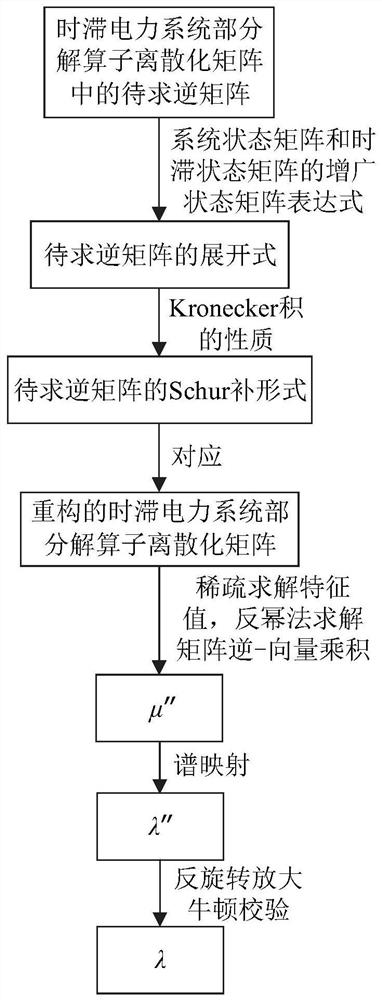High-efficiency eigenvalue analysis method and system for time-delayed power systems based on psod
An eigenvalue analysis, power system technology, applied in information technology support systems, electrical components, circuit devices, etc., can solve problems such as large amount of calculation and low computational efficiency, and achieve high efficiency, improved computational efficiency, and good applicability. Effect
- Summary
- Abstract
- Description
- Claims
- Application Information
AI Technical Summary
Problems solved by technology
Method used
Image
Examples
Embodiment 1
[0033] Such as figure 1 As shown, Embodiment 1 of the present disclosure provides a PSOD-based high-efficiency eigenvalue analysis method for time-delay power systems, including the following steps:
[0034] Step (1): The partial solution operator discretization matrix of the time-delay power system obtained by the PSOD method;
[0035] Step (2): Using the system state matrix and the augmented state matrix expression of the time-delay state matrix, expand the system state matrix and the time-delay state matrix in the inverse matrix to be found in the discretization matrix of the partial solution operator;
[0036] Step (3): Using the distribution rate of the Kronecker product, the mixed product and the inverse property, the inverse matrix to be obtained is further expressed in the form of Schur's complement;
[0037] Step (4): Use the subspace method to calculate the set number of eigenvalues with the largest modulus of the discretization matrix of the solution operator par...
Embodiment 2
[0113] Embodiment 2 of the present disclosure provides a PSOD-based high-efficiency eigenvalue analysis system for time-delay power systems, including:
[0114] The data acquisition module is configured to: acquire the operating state data of the time-lag power system;
[0115] The preprocessing module is configured to: use the PSOD method to obtain the partial solution operator discretization matrix of the time-delay power system;
[0116] The processing module is configured to: use the subspace method to calculate the first eigenvalue of the preset number of partial discretization matrices of the solution operator; in the subspace method, the inverse matrix to be found in the partial solution operator discretization matrix Expressed as the form of Schur's complement, use the form of Schur's complement to obtain the expression of the matrix inverse and vector product, and use the inverse power method to solve the product of the matrix inverse and vector;
[0117] The eigenva...
Embodiment 3
[0120] Embodiment 3 of the present disclosure provides a medium on which a program is stored, and when the program is executed by a processor, the steps in the PSOD-based high-efficiency eigenvalue analysis method for a time-delay power system as described in Embodiment 1 of the present disclosure are implemented, The steps are:
[0121] Step (1): The partial solution operator discretization matrix of the time-delay power system obtained by the PSOD method;
[0122] Step (2): Using the system state matrix and the augmented state matrix expression of the time-delay state matrix, expand the system state matrix and the time-delay state matrix in the inverse matrix to be found in the discretization matrix of the partial solution operator;
[0123] Step (3): Using the distribution rate of the Kronecker product, the mixed product and the inverse property, the inverse matrix to be obtained is further expressed in the form of Schur's complement;
[0124] Step (4): Using the subspace ...
PUM
 Login to View More
Login to View More Abstract
Description
Claims
Application Information
 Login to View More
Login to View More - R&D
- Intellectual Property
- Life Sciences
- Materials
- Tech Scout
- Unparalleled Data Quality
- Higher Quality Content
- 60% Fewer Hallucinations
Browse by: Latest US Patents, China's latest patents, Technical Efficacy Thesaurus, Application Domain, Technology Topic, Popular Technical Reports.
© 2025 PatSnap. All rights reserved.Legal|Privacy policy|Modern Slavery Act Transparency Statement|Sitemap|About US| Contact US: help@patsnap.com



